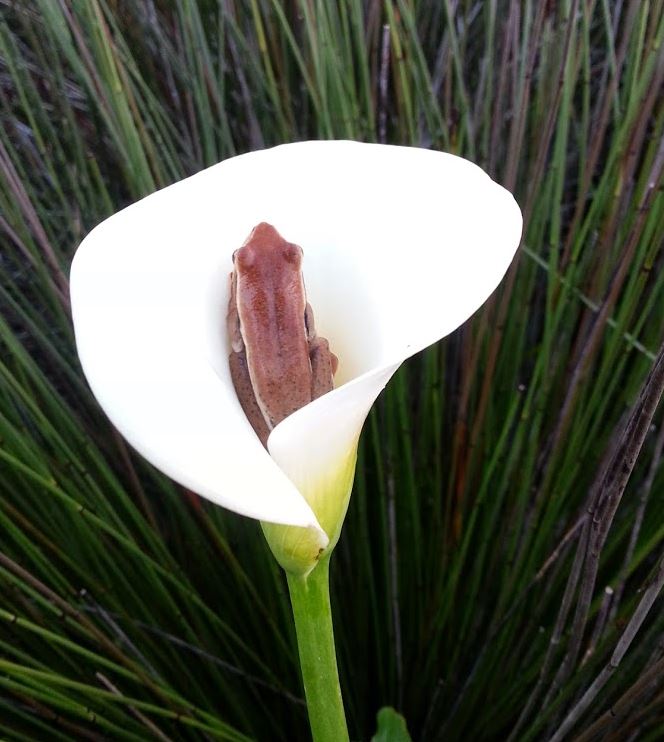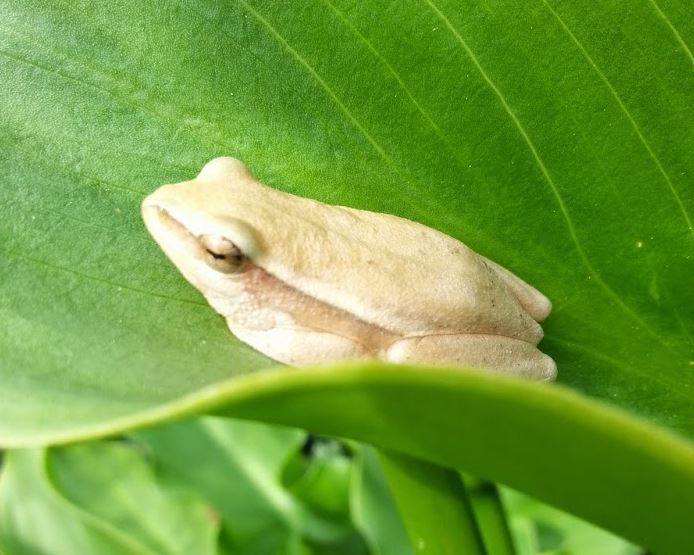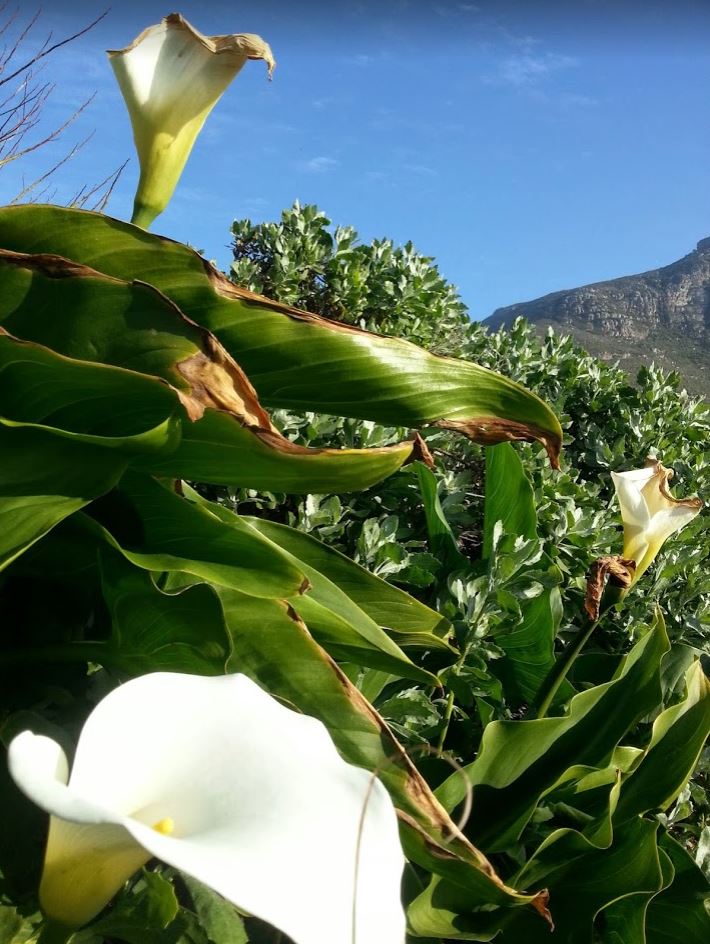What has selling Arum Lilies and Arum Lily frogs got to do with one another?
The answer seems to surprise many people - that picking and selling the flowers has very little impact on the frogs.
The myth just keeps going around and coming back, and I thought I'd write this blog today as I've just been interviewed on Kaapse Kansel (Cape Pulpit) Radio's Dimitri Murray, who was asking what the connection is.
Why do people think that there's a problem?
In South Africa's Western Cape, and more specifically in Cape Town, it's not unusual to see people selling large bundles of Arum Lilies at traffic lights (known locally as robots). The flowers are very beautiful and also plentiful, growing along the sides of many roads, typically in wet areas. It is assumed (probably correctly in the majority of cases) that those selling flowers have picked them without any permission. Thus, some people were discouraging about the selling of wild picked flowers, but somehow another element crept into the story.
The Arum Lily Frog (Hyperolius horstockii) which is endemic to the south-western are of the South African Cape, is called after the flower as adults are regularly seen in a water conserving posture inside the flowers. And it's true, even I've seen it!
And when you do see it, you remember it, as it's a really picturesque sight. There must be hundreds of images of these frogs in the cups of flowers. But they also sit on leaves of Arum Lilies.
And the reason why they sit in the flowers and on the leaves is that these plants represent large flat, smooth surfaces for the frogs to take up their water conserving posture. Note how in both pictures above the frogs have their legs tucked right in. Their backs which can be exposed to the sun are resistant to dessication, while they are very capable of soaking up water through their porous bellies. So this posture helps them conserve water in dry conditions.
A campaign ensued, and an email containing all sorts of mis-information went viral, telling people not to buy flowers as this would threaten the frogs. Not true. There is no direct relationship between conservation of Arum Lily frogs and Arum Lily flowers.
However, you may not want to buy flowers that have been illegally harvested at robots. Pickers need permission from land-owners, and if they don't have that it's not legal. But that doesn't have anything to do with the frogs.
Back in 2010, when I was working at the South African National Biodiversity Institute, we issued a joint statement on Arum Lily Frogs and Arum Lilies with the City of Cape Town and CapeNature (see below).
CITY OF CAPE TOWN - MEDIA RELEASE - 30 AUGUST 2010
JOINT STATEMENT BY:
* CITY OF CAPE TOWN
* CAPE NATURE
* SOUTH AFRICAN NATIONAL BIODIVERSITY INSTITUTE
Setting the facts straight on arum lilies and frogs
The City of Cape Town’s Environmental Resource Management (ERM) Department has noted that inaccurate information is circulating about the sale of arum lilies, and the protection of two of the Cape’s amphibians, the arum lily frog and micro frog.
A campaign urging residents not to purchase arum lilies from vendors at the side of the road seems to be gaining momentum whilst spreading inaccurate information about arum lilies and frogs. This misleading information has also gone viral, and is being spread via e-mail and social networking tools. It is important that the public understand the facts about these frogs, before making a decision on whether or not to purchase the flowers.
The ERM Department, in conjunction with CapeNature and the South African National Biodiversity Institute would therefore like to highlight the facts.
The information being circulated refers to the ‘arum lily micro frog’ which does not exist. There are, however, two different species of frog, namely the micro frog (Microbatrachella capensis) and the arum lily frog (Hyperolius horstockii). The micro frog is smaller than a fingernail, while the arum lily frog is somewhat larger, growing to about 40 mm in length. It has been reported that the ‘arum lily micro frog’ is in danger because of the sale of arum lilies, but this is not at all correct for either of the frog species.
The supposed threat to these frogs’ habitat has been cited as one of the main reasons why the public should not buy arum lilies. However, no frog species breeds in the flowers of arum lilies. While the arum lily frog occasionally uses the flowers for shelter, it is not dependant on them. Arum lily frogs breed in wetlands and not in the flowers of the arums. The micro frog is ground-dwelling, breeding in temporary pools, and it does not climb into any flowers.
Arum lily frogs are very pale and they hide their bright orange feet and legs under their bodies during the day. In this way, the frog is able to use a white background as camouflage against predators and this background is sometimes the white arum flower. They do not use the pollen of the flowers to camouflage themselves, as has been suggested.
While arum lily frogs are only found in the Western Cape (and a small area of the Eastern Cape), they are not classified as threatened in the 2004 Red Data book. However, it is true that the species is becoming increasingly rare as their habitat is lost to urban development.
While the illegal harvesting of arum lilies will not lead to the extinction of arum lily frogs, the sale of illegally harvested flora at traffic lights is cause for concern. If left unchecked, other illegally harvested plants such as proteas, ericas, and various bulb species may be seen at traffic lights in the future.
The City does not wish to deter the public from purchasing flowers from hawkers – as long as they are legal retailers. All roving vendors and intersection traders selling flowers are illegal. However, traders selling flowers in demarcated trading bays are legal, and regulated by the City. The City encourages the public to report illegal trading on 021 596 1400/1424.
“The ERM Department is always grateful when residents spread its messages because the need for awareness is so great. Unfortunately, this message has become lost in translation, and we hope that the correct information, as it appears above, will spread in the same manner,” said the City’s Biodiversity Co-ordinator, Clifford Dorse.
The ERM Department is currently updating its pamphlets on frogs and lilies, and will distribute them widely in an attempt to ensure that the public receives the correct information.
End
Issued by: Communication Department, City of Cape Town
Media enquiries: * Clifford Dorse, Biodiversity Co-ordinator, Biodiversity Management Branch, City of Cape Town, Tel: 021 514 4159, Cell: 083 440 1751
* Dr John Measey, [then of the] South African National Biodiversity Institute




